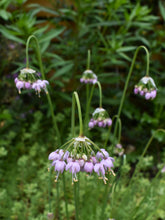
Allium cernuum
Nodding onion flaunts showy clusters of numerous, dusty-pink flowers that are so big compared to its stem that they appear to be nodding. This wild onion is host to hairstreak butterfly caterpillars and a nectar source for many insects. But, interestingly, its grass-like leaves also can act as a repellent for garden pests. All parts of the plant; leaves, bulbs and bulblets are all edible and pungent.
- Plant type/canopy layer: deciduous, perennial, herbaceous plant
- Size at maturity: 6-12" tall, 12-18" wide
-
Light requirements: full sun to part shade
- Moisture requirements: dry to moist soil, well-drained
- Bloom time: May - July
- Growth rate/ease: medium growth rate, easy to grow
- Wildlife support: flowers attract and provide nectar to hummingbirds, adult butterflies, bees and other insect pollinators; overall plant attracts and support beneficial and pest eating insects
- Native habitat/range: locally common in moist rocky soils, from coast to subalpine elevations, in Oregon, Idaho, and Washington, north to British Columbia, east Montana, and southeast to Arazonia and Mexico. Portland Plant List - yes.
- Special uses & features: edible; hummingbird and butterfly favorite; deer resistant; landscape used include rock gardens, meadowscapes and pollinator gardens
What to Expect + Gardening with Nodding Onion: For spring orders, depending on the weather and the date of your order pick-up, spring bulbs may be just emerging or already done for the season. Alliums are generally less fussy and can easily be planted in spring, as long as it's done with care. For fall orders, you can expect what looks like a pot of dirt. The bulb inside will likely appear shriveled, which is its normal, dormant fall look. Fall is generally considered an excellent time to plant bulbs.
Nodding onion is hardy and gorgeous in sunny, exposed and/or rocky areas and is one of the few species that will tolerate growing beneath a black walnut tree. Though it prefers soils that are moist but well-drained, it can be exceptionally drought tolerant. As an edible plant, whose grasslike green leaves repel garden pests, it's a natural addition near your veggie garden! It is a striking, yet small plant - so be sure to plant it in multiples to get the full effect. It makes an excellent border when planted densely along an edge. It can reseed, but the seeds will take many years to become a new flowering plant.
Photo Credit 1: "Nodding Wild Onion (Allium cernuum)" by wackybadger is licensed under CC BY-SA 2.0.
Photo Credit 2-5: Nikkie West, Sparrowhawk Native Plants









